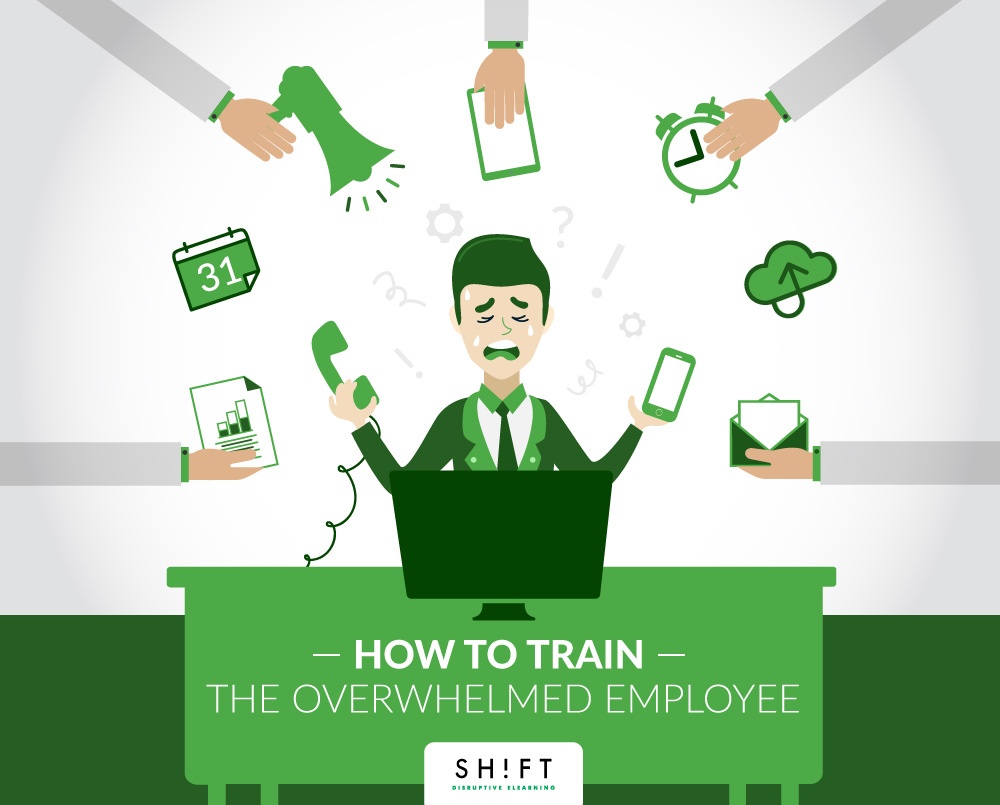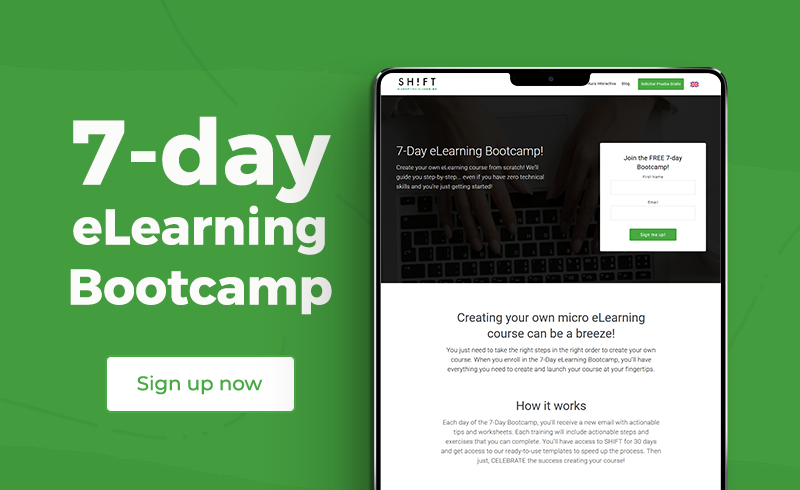They often forget dates and end up missing social engagements or the kid’s soccer matches. The smartphone rings and they lose the thread of their thoughts. An email notification pops up, and they stop typing a report to send to their boss.
This is your average employee (and probably you feel identified too). This is how people work—answering phones in between drafting reports, updating Facebook statuses while writing codes, and attending sundry meetings in between their daily tasks.
Now would you be surprised if you knew that people usually forget 90 percent of what they learn within one week after the training event? (More stats here.)

Meet the “Overwhelmed” Employee
You meet him/her in the corridor as he rushes from one meeting to another, a harried look on his face. You see them hunched in front of her computer, juggling more windows than they can manage comfortably.
Average employees are talented, intelligent, and dedicated, YES. But they are so trapped in the maze of technology that they cannot concentrate on the job. They are so distracted by technology that they cannot perform to their true potential.
Bersin by Deloitte has published numerous reports on the “overwhelmed” employee. In this report, they describe this worker to be in a permanent “on” status 24x7x365—always working, hyper-connected, and overloaded with information and stimuli.
The plethora of gadgets they constantly use keeps them tethered to their job round-the-clock. According to a Gallup report, two-thirds of full-time American workers report that they have started working more outside of the usual working hours after smartphones and mobile internet came along.
Sundry social media obligations distract them as they try to work. According to neurologist Larry Rosen, your average employee focuses on a single task for only seven minutes before getting distracted. And the distraction is most likely a beeping, blinking, or buzzing phone because mobile device users check their phones about 150 times daily!
With so many distractions, productivity wanes, creativity fizzles out, learning is impaired, and performance nosedives. It is no wonder that the overwhelmed employee spends long hours at work than ever before. According to this research, 40 percent of men work more than 50 hours a week, and 80 percent of them want to do something about this situation so that they can enjoy a work-life balance.
The “overwhelmed” employee is not only standing in his/her own way but is also a drain on the company. About 65 percent of HR and training managers and business leaders recognize the sheer challenge of making these overwhelmed employees “learn.”
The mind overloaded with information and constantly distracted by stimuli can learn only so much.
In this post, we give you the low-down on four effective learning strategies to engage your overwhelmed employees in your eLearning programs:
Check them out:
1) Space Out the Learning
According to research conducted at Oxford University, students tend to retain knowledge better when they take regular breaks between studying. Spacing out your employee's learning sessions gives breathing space to the brain and helps to cement the new learning. So, cramming DOES NOT work, as we have explained in our post here.
Here’s how you can design such spaced-learning programs for your employees to minimize learning loss:
- Chunk the content to create micro-modules of learning that you can deliver in short bursts.
- Create a schedule where you alternate training sessions with gaps during which employees go back to their jobs and practice what they have learned.
- Ensure that you repeat the learning—a particular concept or skill—after a few days, weeks, or months. The number of repetitions will depend upon the complexity of the content.
- Adjust the intervals between training sessions depending upon the nature of the content and the time the learners should ideally receive to apply and practice their newly-learned skills on the job.
Also read: How to Design eLearning Programs with Spacing In Mind
2) Make Content Easy to Search
According to the findings of a Deloitte study conducted on employees at 3,300 multinational corporations in 106 countries, 72 percent of workers reported wasting frustrating amounts of time trying to locate relevant information on their company’s database. This makes learning burdensome and demotivates many employees.
If you have created a database of training courses for your employees, ensure that it does not turn into a maze where they waste time trying to find their way. Make content easy to search for and locate.
Here’s how you can do that:
- Make information searchable by providing different search options, from basic keyword-based searches to more advanced queries based on multiple parameters and filters.
- Make it easy for your employees to locate learning communities and subject matter experts within the organization.
- Establish concrete rules of use, so all your employees know how to navigate the systems and find the information they are looking for.
- Create an intuitive and responsive knowledge system that also records employee learning needs and/or preferences and filters and recommends learning modules to them. This creates a personalized learning experience, but more on this later in the post.
3) Self-directed Learning Rocks
Adult learners want to be in control of what is going on in their lives, and that includes how they learn at the workplace. People look forward to the learning experience and engage with a course more enthusiastically if they feel they would be in control during the journey.
The stressed and overwhelmed employee craves some breathing space. They have clients to satisfy and deadlines to meet at the workplace and hankers for a little me-time. Many of them are caving in under a mountain of responsibilities at home and feels they can’t concentrate on their career. The average worker today works for more hours than before and yet feels he or she is not doing enough. They are pulled in all directions and stretched thin.
The last thing you would want to do is make an overwhelmed employee perceive learning as a chore. [tweet this]
So let them be in the driver’s seat and give them that refreshing, empowering feeling of being in control.
Here’s how:
- Do not tether learning to the desk. Instead, give employees the option to learn when and where they want to. Create responsive eLearning courses that you can deliver on any device.
- Let employees choose the courses they want to take depending on their job requirements and/or knowledge gap. Allow them to skip modules while taking a course and learn at their own pace.
- Create a flexible learning schedule where learners don’t feel pressured to complete a certain number of courses within a specific period.
According to a research study by Regus, 72 percent of global companies reported increased productivity amongst employees, reduced absenteeism, and increased worker morale and loyalty when they adopted flexible working and learning practices.
Read more:
How to Promote Self-Directed Learning in Your Company
Here’s Everything You Need to Know About Self-Directed Learning at the Workplace
4) Create Personalized Learning Journeys
The average worker in your organization is overworked, time-crunched, and overwhelmed. He or she is trying to accomplish too many things all at once but doesn’t have the time. It is no wonder that they report a lack of time as the single biggest obstacle to learning at the workplace.
So now that you have a clear picture of what’s keeping your employees from learning effectively, here’s a nifty idea. Why don’t you consider creating personalized learning experiences for employees?
Customized courses deliver exactly what a particular learner needs to know just when he needs it. They improve upon generic or role-based training programs that tend to deliver a lot of information that the learner finds repetitive or irrelevant.
Also read: How to Make Your eLearning Courses More Personalized
It has been proven that the personalization strategy works for consumers, and today’s learners want to behave like consumers.
Technology has made it possible for L&D professionals to create courses that address not only the training needs of a learner but also the learning requirements he needs to fulfill future goals.
As an L&D professional, ensure that your learning platform performs the following tasks effectively:
- Provide tests to evaluate individual skill and knowledge levels
- Determine what course a learner needs based on his existing level of knowledge and provide recommendations for recommendation engines created by Amazon and Netflix.)
- Track course completion
- Record employee training progress and allow employees to access these reports
- List the courses available to a particular employee based on his training requirements
- House a database of training materials that learners can access according to their Just-in-time needs.
- Facilitate communication amongst learners and between learners and trainers so they can ask spontaneous questions.
A personalized learning program that delivers focused and relevant content increases productivity by cutting down on unnecessary “compulsory” training. When you make the effort to create a learning environment where employees feel supported and enriched, you create a breed of loyal and satisfied workers who are motivated, engaged, and committed to giving their best.
Read more: Learner Experience Mapping: Building Personalized “Learner-centric” Experiences
REFERENCES:
Why Personalization is the Best Way to Re-Engage the Corporate Learner
Why Companies Fail To Engage Today's Workforce: The Overwhelmed Employee
Why is spaced learning a vital component of effective employee training and education?

